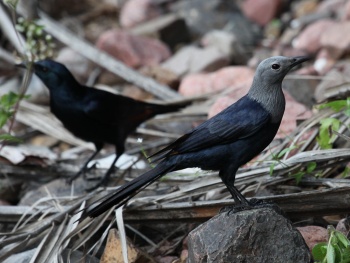Alternative names: Somali Chestnut-winged Starling; Somali Red-winged Starling
- Onychognathus blythii
Identification
28cm. A rather large, dark starling with a long, graduated tail.
- Purple-black plumage with some gloss
- Reddish-brown primaries
- Reddish-brown eyes
- Black bill and legs
Females have an ash-grey head and breast. Juveniles are similar to males but duller sooty brown and have a brown eye.
Similar species
Socotra Starling has a shorter tail, a darker eye and is generally smaller.
Distribution
Found in Eritrea, Djibouti, northeast and central Ethiopia, northern Somalia and on Socotra (Yemen).
Common to abundant. More common on Socotra than Socotra Starling.
Taxonomy
This is a monotypic species[1].
Habitat
High mountains in arid regions, rocky cliffs at lower elevations. Breeds mainly above 1000m up to 3000m.
Behaviour
Usually seen in flocks of up to 20 birds, some huge roosts are reported from deep gorges in Ethiopia.
Diet
Feeds mostly on fruit and insects.
Breeding
Breeding season April to May and September in Ethiopia, November to April on Socotra. A monogamous species. The nest is placed in a cliff hole, a cave, sometimes in buildings. Lays 4 -5 eggs.
Movements
A resident species with some altitudinal movements.
References
- Clements, JF. 2010. The Clements Checklist of Birds of the World. 6th ed., with updates to December 2010. Ithaca: Cornell Univ. Press. ISBN 978-0801445019. Spreadsheet available at http://www.birds.cornell.edu/clementschecklist/Clements%206.5.xls/view
- Del Hoyo, J, A Elliott, and D Christie, eds. 2009. Handbook of the Birds of the World. Volume 14: Bush-shrikes to Old World Sparrows. Barcelona: Lynx Edicions. ISBN 978-8496553507
Recommended Citation
- BirdForum Opus contributors. (2025) Somali Starling. In: BirdForum, the forum for wild birds and birding. Retrieved 12 April 2025 from https://www.birdforum.net/opus/Somali_Starling





